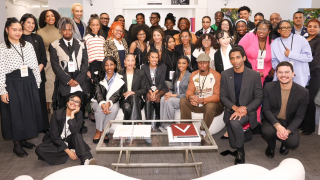Harm and horror at the hands of oppressive White lawmakers is something Black Americans have been accustomed to for centuries. It’s only today that we live in a time when the injustices and violence are in plain sight of all with working eyes and ears. The gruesome violence that led to the Eric Garner, Sandra Bland and other tragedies are forever captured on video. But it was 60 years ago when such a tragedy experienced its first “viral” moment, when Mamie Till decided to open the casket of her lynched son, Emmett, showing the world what “racial hatred” looked like.
That image that inspired TV producer Keith Beauchamp to tell the story of 14-year-old Till, who was brutally killed for whistling at a White woman in Mississippi. Beauchamp has dedicated his life exposing the truths of Till and other civil rights martyrs through documentary (The Untold Story of Emmett Louis Till), television work (The Injustice Files), and partnership with the FBI, investigating civil rights cold cases.
His forthcoming project, Till, gives Emmett’s story the feature film treatment, with Whoopi Goldberg on board as a producer. Beauchamp spoke to EBONY.com about Till and his mother.
EBONY: You first learned about Emmett Till in Jet magazine at age 10. Take me back to that moment.
Keith Beauchamp: I was in my parents’ study, rummaging through old vintage magazines that just happened to be Jet. I put my hand on an anniversary copy of Jet magazine that talked about the Till story. I opened the magazine, not knowing what I would see, and I saw these photographs. One side, there’s this angelic face of this little boy—sort of a mirror image of myself at the time, me being 10 years old. And on the other side, there’s this horrific face of this monster. I couldn’t believe what I was holding!
My parents just happened to walk by the study at that same moment that I saw the photograph. They saw me shocked; they came in and saw what I was looking at and sat me down and right then and there, told me the story about Emmett Till. I could never get this little boy’s image out of my head.
EBONY: Did it ever occur to that you wanted to do a film on Emmett Till before you started working in film business?
KB: I wasn’t going to go any further until I had the blessing of Mamie Till-Mobley. I reached out to her and we talked on the phone for months before I finally met her in the fall of 1996. It was from that point forward that she gave me the blessing to continue what I was doing, to help her get justice for her son.
So my first mission was to get this done as a movie, a feature film. I ended up writing a script, and some producers who worked with Showtime at the time optioned off my screenplay. When they option off the screenplay, of course, I didn’t have any control at that point, and it was just gone. I felt bad that it was done that way, but from the encouragement of the late Mamie Till-Mobley, she stood at my side and said, “Keith, you’ve come across a lot of good information and we need to get this out immediately. Why don’t you do a documentary first?”
And that’s what we did. We did the documentary to use that as a stepping stone to get the case reopened. It took nine years to produce the film. A lot of my time was taken trying to convince people to tell me the story of Till. A lot of them didn’t want to be filmed; it was very hard for them to talk about.
EBONY: In the documentary, one of the witnesses had to cover her face. People are still afraid.
KB: It’s amazing, because as you said, even if you go there today, if you go to the Delta and ask anybody about Emmett Till, watch how they freeze up. Still today that story is a thorn in many people’s sides. But to be honest with you, the overwhelming poverty, the overwhelming crime, the racial crimes that continue to happen there, nobody hears about. It’s seems to me they’re still living behind this iron curtain, and when I say that, I mean that seriously.
All that has happened since the reopening of the case with the tourism and everything that’s going on, where you see millions of dollars being pumped into this Emmett Till tourism—buildings, refurbishing the court house to its original state as it was in 1955 during the trial, these bus tours—millions of dollars being pumped into these initiatives. But you don’t see that the community is still suffering.
EBONY: Do you think the tourism and attention is good or bad, ultimately?
KB: It’s both. It’s a good thing because of the fact that people need to hear and understand the Till story. It’s important to preserve that history, a history that has been forgotten when you talk about civil rights in this country. It was because of Till that Dr. King solidified his participation in the Montgomery Bus Boycott, because he felt the Emmett Till murder case was an intimidation factor to keep Black people away from the polls. 1955 was an election year.
On the flipside of it, I hope I’ll be able to see some financing going into the communities that need it most in the Delta. It’s frustrating to have all these tours happening, and yet nothing is changing in the surrounding areas in the Delta. It’s just terrible.
EBONY: How does it make you feel to know that we can see the acts of Black Americans being victimized but the people committing the crimes are not being brought to justice?
KB: Cosmetically, things have changed. There are many things that remain the same. I’ve become a student of civil rights history because I deal with these murders all the time. When I investigate a specific murder, I have to do a lot of background in the backdrop in which this murder occurred. I’m privy to that history on how these murders were organized and why.
But I can tell you that I never thought in a million years that I would actually see history repeat itself in my short lifetime. Technology has made it easy for us to exchange information and get it instantly. These murders and injustices have been occurring throughout our history. It’s nothing different; they’ve been happening. It’s just that a lot of us don’t hear about it. It’s true what Mamie once said about her son: at one time she would hear these murders taking place and she’d shake that off and say that’s not her problem. But when the murder came to her front door, it became more than a problem for her.
EBONY: How far into the feature film have things gotten to this point?
KB: Nothing has been shot. We finished developing the script. I’m one of the co-writers of the script. Michael Riley is the second co-writer. As I said, it’s adapted not only from my documentary on Emmett Till, but also the book by Simeon Wright. It’s also based on all the research I did to get the case reopened.
EBONY: How did Whoopi Goldberg and Fred Zollo get involved?
KB: Fred Zollo is the man behind the films Mississippi Burning and Ghosts of Mississippi. It was important for me to line up with Fred for this, because Fred became an inspiration for many investigative journalists and filmmakers around the country to tackle these issues, to get them on screen and make an impact. It was easy to line up with Fred because he’s connected to Mississippi. We speak the same language and passion.
Over a period of time, he teamed up with Thomas Levine of Paramount. Fred and Whoopi had been knowing each other for a long period of time, and you recall in Ghosts of Mississippi, she played Mrs. Evers. I was introduced to Whoopi a number of years ago, went to her house and we would talk about Till and my work. We always said we wanted to do it, but the timing wasn’t right. It wasn’t until all these shootings started occurring over and over again, I said, “We gotta get Till out. This is the perfect time for it.” We’ll be shooting in the spring of 2016. I’m extremely happy about that. It’s an honor to work with Whoopi and Fred.













